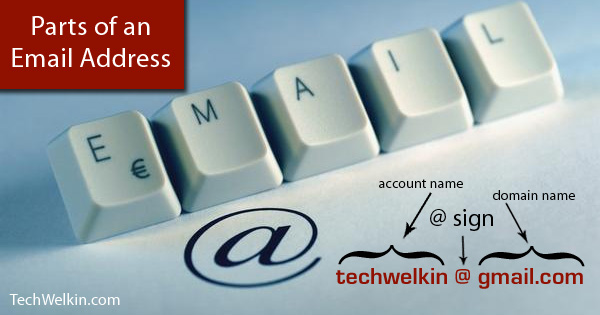“Should email id be in all caps?”, asked a person to whom I was dictating my email address over the phone.
Such questions, howsoever irrelevant, are frequently asked questions. Electronic mail (email) provides us a way of sending messages at lightning fast speed. Although email is an integral part of the modern day communication but common man is still ignorant about a few facts on the all important: the Email Address.
So, today, my dear readers, I will talk about the structure of email address and will tell you about various parts of an email address. Sometime ago, I wrote a similar article on the parts of a web address (URL).

Every email address has three main parts. It’s useful to understand the components of an email id.
An email address has three main components. For the sake of simplicity, this is how it can be demonstrated:
accountname @ domain.com
1) Domain name: This part of the email address is the name of server that hosts your emails. It is not necessary that the domain name would always be of a .com kind. It can be anything from the standard list of domain extension (e.g. .org , .net , .gov, .co.in etc.)
A server could that be of a free web-based email service provider (like Gmail, Hotmail, Yahoo! Mail etc.) or server may belong to a specific organization (for example, if you’re working in a company named XYZ … the server name could be xyz.com)
2) Account name (or username): An email hosting server may host emails for one person —or millions of persons. You can imagine your account like a pigeon-hole or letter box whose key only you have. This key is called… yes, you guessed it right!… it’s called password ! Allow me to add a word of advice here. You should set your passwords to be strong. Weak passwords can compromise security of your email account.
Having said that, let’s proceed…
All the email account names on a server has to be unique so that the server can send emails to various accounts without any confusion. There can not be two accounts with the same name on a server. Therefore, two techwelkin @ gmail.com are not possible. But techwelkin @ gmail.com and techwelkin @ yahoo.com are possible. The account name (i.e. the part before @ sign) refers to the user/owner of the email address.
3) @ Sign: First thing first, in case of email address, this symbol is pronounced as at and not as “at the rate”
This symbol is used in an email address to separate account name from domain name. When a computer tries to understand an email address, it splits the address from @ sign. The part of email address that comes before @ is account name and the part that comes after it is domain name. Simple!
There must be one (and ONLY one) @ sign in an email address. If the address does not have this sign —it is not a valid email address.
Ok, now that we know the structure of email address, let’s understand a few more things:
- Email addresses are not case-sensitive. This means it does not matter whether you write address in uppercase or lowercase or mixed case. (ONLY rarely the account name may be case-sensitive but domain name is never case-sensitive)… All free web-based email services use non-case-sensitive addresses… Therefore:TECHWELKIN @ GMAIL.COM is same as techwelkin @ gmail.com
- Conventionally, however, email addresses are written in small letters. But as said in previous point, it would not matter even if you write it in capital letters.
- To show the account holder’s real name against an email id, the email id is enclosed in angular brackets.
For example:Lalit Kumar <techwelkin @ gmail.com> - Account name can not be longer than 64 characters and domain name can not be, practically, longer than 254 characters.
So, these were the details about parts of email address. I hope that these were useful and clarified doubts about the ubiquitous address of communication in the virtual world. Please let me know your comments and questions.

thank you for your help
So well written – thank you.
Question; because I’ve recently received emails from someone I’d like to block but somehow Outlook hasn’t seen them as Junk.
I wonder, can I can block only the domains, in these cases alloloc.com and clubracer.eu ?
By the way you said ONLY rarely the account name may be case-sensitive. I’ve been telling folks that only people who think they are important, such as politicians use upper case first letters of their names. Is that not quite correct?
Awaiting your reply, sun-cerely
can you please explain to me about “cc & Bcc”?
THANK YOU FOR YOUR HELP, I APPRECIATE IT
Thanks for the details about email addresses. There is 1 part I still need to understand. Some emails have another “dot: in the domain side, such as “em.yahoo.com” I don’t know if this one really exists). What are the extra “dot” and letters before the domain name?
cw
That extra do separates domain from sub-domain. Please read our article on URL structure to understand it better.
it was really helpful in some matter to solve out. thank you for this valuable information linked here.
Very useful information on structure of email address. Thank you.
can you please tell me whats the structure of an email using an example
Please elaborate your question. The article itself was written for the purpose of explaining the structure of an email address.
Thanks for sharing.
Can you please tell me how to link emails using anchor tags in a html page.
Hi Dinesh,
You can use mailto for this purpose. The example HREF is: href=”mailto:[email protected]”
Thanks a lot sir.